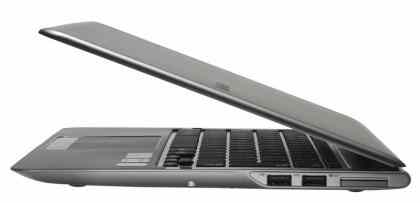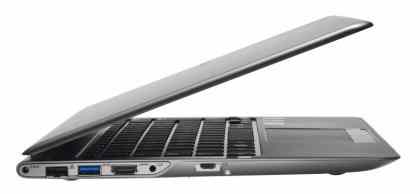It has barely been a year since Intel launched its Ultrabook specification, but we’re already seeing plenty of variety from different manufacturers and, refreshingly, prices are slowly beginning to drop. Samsung’s Series 5 could be considered a second generation Ultrabook, and if it’s any indication, the form factor may have finally found its feet.
With its 13in chassis, 18mm thickness and 1.4kg weight, the Series 5 is tiny machine, with delightfully minimalist looks that continue underneath the lid – Aside from the power button, there are no superfluous hotkeys or LEDs, just a Chiclet-style keyboard and an expansive touchpad.

Connectivity is excellent for such a small machine, and Samsung has sensibly decided against copying the port covers from the Series 9. Two USB ports, a single USB3 port and a multi-format card reader are all useful inclusions, plus there's a single 3.5mm headset port. There’s also a full-size Ethernet port, which means you won't be nervously digging in the bottom of your bag for the adaptor. There’s no optical drive here – you’ll need to spend more on the 14in version if you want to be able to play DVDs.

Like all ultrabooks, the Series 5 is powered by an Intel processor. The Core i5-2467m runs at a relatively sedate 1.6GHz, but can Turbo Boost up to 2.3GHz for extra performance when needed. Combined with 4GB of RAM it completed our multimedia benchmarks with an overall score of 35. This isn’t exactly lightning-fast, but it’s more than quick enough to run all your everyday tasks.
Intel’s processor also provides the graphics power, using its integrated GPU. It’s fast enough for high definition video, at 720p on the laptop or 1080p using the HDMI output, but it struggles with modern games. Our Dirt3 test chugged along at 12.8fps, proving you’ll need to stick to older titles in order to achieve a playable frame rate.

In order to undercut much of the competition with the Series 5, Samsung has opted to use a traditional hard disk rather than an SSD, combining it with 16GB of flash memory to speed up file transfers. It’s an Intel technology called Smart Cache, but Samsung has labelled it Express Cache here - either way, it makes a big difference to start-up times. Compared to the 54 seconds it took to boot without any assistance, the Series 5 reached the Windows desktop in 26 seconds with Express Cache enabled.
The mechanical hard disk will have more of an impact on battery life than an SSD, but the Series 5 still coped well in our light-use test. Lasting a little over five and a half hours away from the mains, you should be able to get a fair amount done before you need to start searching for a plug socket.
